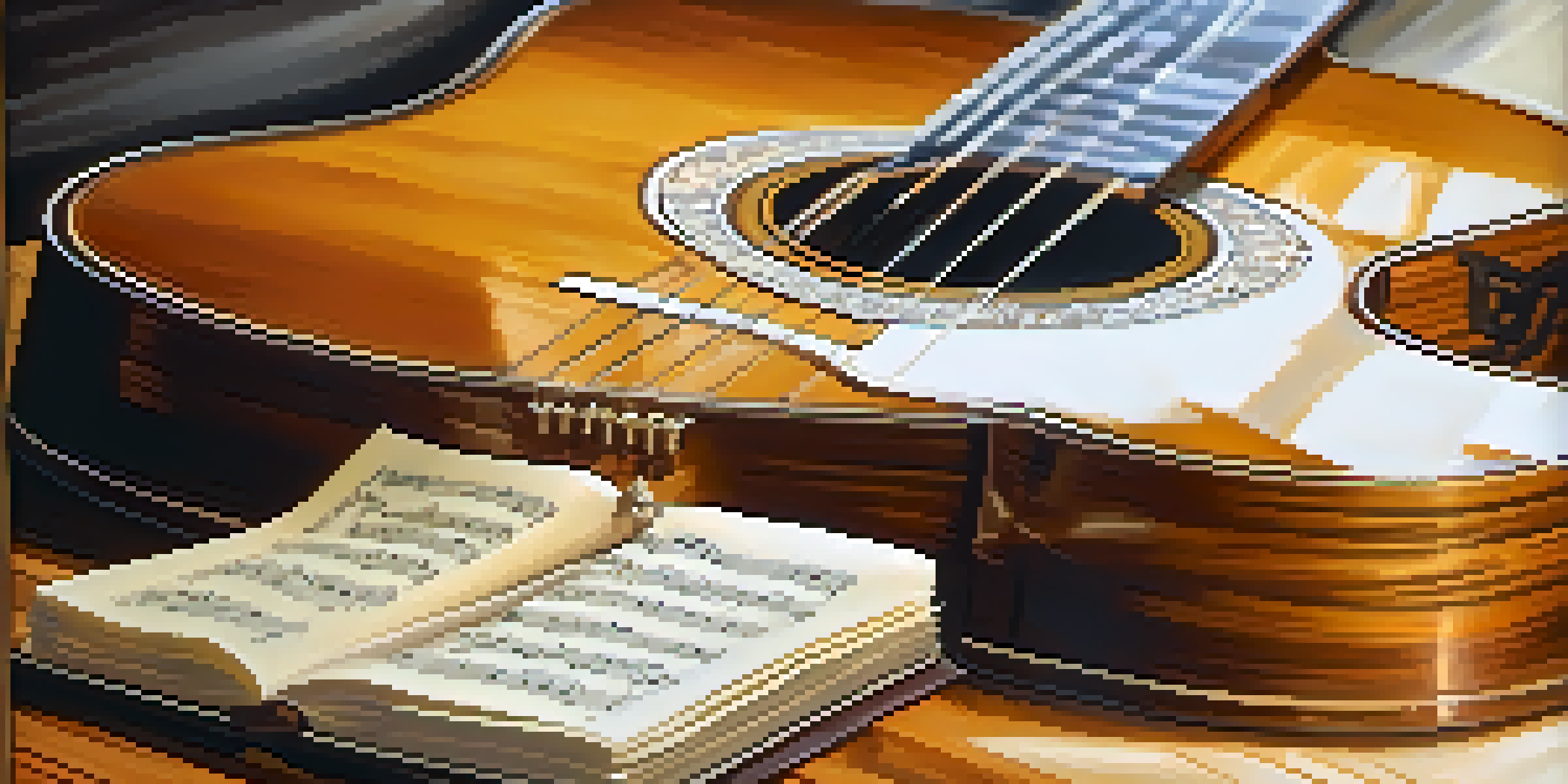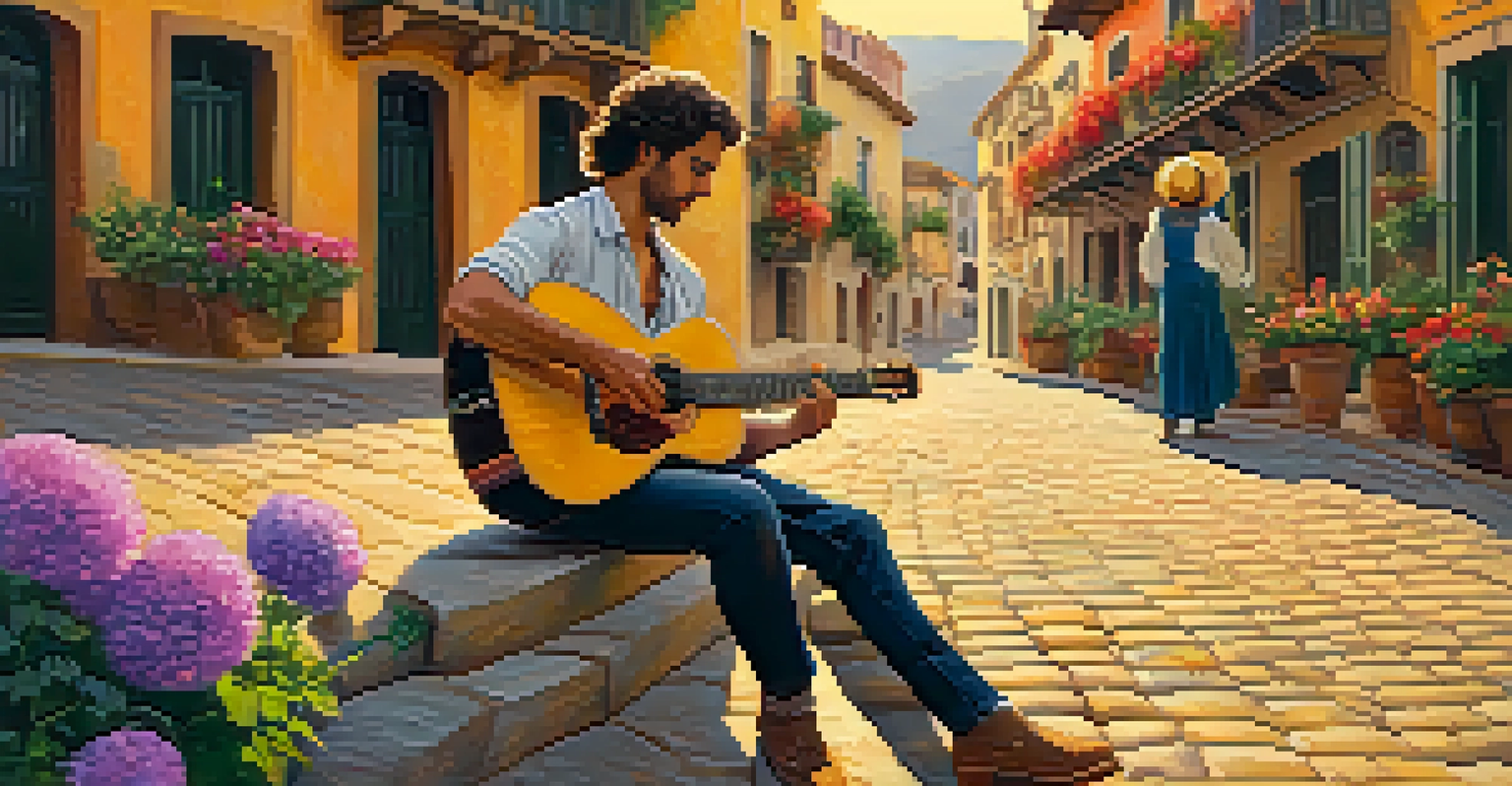The Birth of Classical Guitar: Key Innovations and Styles

The Origins of the Classical Guitar: A Historical Overview
The classical guitar, as we know it today, has its roots in ancient stringed instruments. It evolved from the lute and vihuela, both popular in Europe during the Renaissance. The transition from these early instruments to the modern guitar began in the late 18th century, where players sought a more versatile and expressive sound.
The guitar is a small orchestra. It is polyphonic. Every string is a different color, and when you put them together, you can create a whole world of sound.
By the time of the Baroque period, the guitar was gaining traction, especially in Spain, which became a hub for its development. This period saw the emergence of distinct playing styles and techniques that laid the groundwork for future innovations. The cultural embrace of the guitar in Spain significantly influenced its trajectory and popularity across Europe.
Related Resource
As we moved into the Classical period, the guitar began to take on its contemporary form. Its body shape, string configuration, and playing techniques were refined, allowing for greater musical expression. This evolution set the stage for the rich variety of styles that would follow.
Key Innovations: The Evolution of Design and Technique
One of the pivotal innovations was the introduction of the fan bracing system in the early 19th century. This design allowed for a more resonant sound and greater projection, which was crucial for solo performances. With this change, the classical guitar became a favored instrument for composers and performers alike.

Another significant development was the shift from gut strings to nylon strings in the mid-20th century. Nylon strings offered a more stable tuning and a brighter sound, attracting a new generation of musicians. This transition not only enhanced playability but also expanded the guitar's repertoire, allowing for a wider range of musical styles.
Historical Roots of the Guitar
The classical guitar evolved from ancient stringed instruments like the lute and vihuela, with significant developments occurring in Spain during the Renaissance and Baroque periods.
The invention of the modern tuning pegs also contributed to the guitar's evolution. Improved tuning mechanisms made it easier for musicians to keep their instruments in tune during performances, enhancing the overall sound quality. These innovations collectively transformed the guitar into a serious concert instrument.
The Role of Spanish Guitarists in Shaping the Style
Spanish guitarists played a crucial role in the development of the classical guitar repertoire. Renowned musicians like Francisco Tárrega and Andrés Segovia brought the guitar into concert halls, showcasing its capabilities through their compositions and interpretations. Their work significantly elevated the status of the guitar in classical music.
Music is the literature of the heart; it commences where speech ends.
These guitarists not only performed but also composed pieces that are still staples in today's repertoire. They embraced the guitar's unique sound and incorporated it into classical music traditions, creating a distinct style that resonated with audiences. This fusion of Spanish folk music with classical elements laid the groundwork for future guitar compositions.
Related Resource
The influence of Spanish guitarists extended beyond their performances; they also taught and inspired countless students. Their pedagogical methods helped define how the guitar was taught, ensuring that their innovative techniques would be passed down through generations. This legacy continues to shape the way the classical guitar is approached today.
The Influence of Classical Composers on Guitar Literature
Classical composers have significantly influenced the evolution of guitar literature, enriching its repertoire. Figures like Mauro Giuliani and Fernando Sor composed numerous works that showcased the guitar's expressive capabilities. These compositions not only highlighted the instrument's versatility but also established it as a legitimate medium for classical music.
Throughout the 19th century, the guitar began to feature prominently in chamber music settings. Composers started to integrate the guitar into ensembles alongside other instruments, creating beautiful harmonies and textures. This collaborative approach further expanded the guitar's role in classical music, allowing it to shine in a variety of musical contexts.
Innovations Transforming the Guitar
Key innovations such as fan bracing and nylon strings have enhanced the guitar's sound quality and playability, solidifying its place as a serious concert instrument.
In the 20th century, composers such as Manuel de Falla and Heitor Villa-Lobos contributed to the guitar repertoire with innovative works. Their compositions often blended traditional elements with modern techniques, pushing the boundaries of what the guitar could achieve. This ongoing dialogue between composers and performers continues to inspire new generations of guitarists.
Distinct Styles of Classical Guitar: From Flamenco to Romantic
The classical guitar is characterized by a variety of distinct styles that reflect its rich cultural heritage. Flamenco, for example, is a passionate and rhythmic style rooted in Spanish folk traditions. Its emphasis on percussive techniques and intricate fingerwork showcases the guitar's dynamic range and expressive potential.
Another prominent style is the Romantic guitar, which emerged in the 19th century. This style is marked by its lyrical melodies and emotional depth, often drawing inspiration from the romanticism movement in literature and art. Composers of this era sought to evoke powerful emotions through their guitar works, resulting in timeless pieces that still resonate with audiences today.
Related Resource
Additionally, contemporary classical guitar continues to evolve, incorporating influences from various genres such as jazz, pop, and world music. Modern guitarists experiment with techniques and styles, creating a fusion that reflects today's diverse musical landscape. This adaptability ensures the classical guitar remains relevant and exciting in the ever-changing world of music.
The Rise of Guitar Education and Its Impact on Popularity
As interest in classical guitar grew, so did the establishment of formal education programs. Music schools and conservatories began offering dedicated guitar programs, which helped cultivate a new generation of talented musicians. This structured approach to learning allowed students to develop their skills systematically, ensuring a higher level of proficiency.
The proliferation of guitar competitions and festivals also played a significant role in popularizing the instrument. Events like the Guitar Foundation of America competition showcase emerging talent and provide a platform for performers to gain recognition. These competitions foster a sense of community among guitarists, encouraging collaboration and inspiration.
Diverse Styles and Education Growth
The classical guitar boasts various distinct styles, from flamenco to romantic, while the rise of formal education and competitions has significantly increased its popularity.
Moreover, the accessibility of instructional materials, including books, online tutorials, and video lessons, has made learning the classical guitar more attainable than ever. This democratization of guitar education has opened doors for aspiring musicians, allowing them to explore the instrument's beauty and complexity without the barriers of traditional learning.
The Future of Classical Guitar: Innovations on the Horizon
Looking ahead, the future of classical guitar is bright, with continuous innovations shaping its trajectory. Advances in technology, such as digital music production and online collaborations, are expanding the possibilities for guitarists. These tools allow musicians to experiment with sound and reach audiences in new ways, redefining the boundaries of classical music.
Additionally, the global exchange of musical ideas is influencing the evolution of classical guitar styles. As musicians from different cultures and backgrounds come together, they bring unique perspectives and techniques that enrich the guitar's repertoire. This fusion of styles creates a vibrant and diverse landscape for classical guitar.

Finally, as the world becomes increasingly interconnected, the classical guitar will continue to adapt and thrive. New genres and influences will emerge, ensuring that this beloved instrument remains relevant and continues to inspire future generations of musicians and audiences alike.